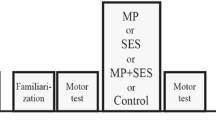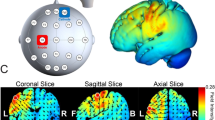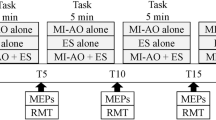Abstract
Introduction
The double-cone coil (D-CONE) is frequently used in transcranial magnetic stimulation (TMS) experiments that target the motor cortex (M1) lower-limb representation. Anecdotal evidence and modeling studies have shed light on the off-target effects of D-CONE TMS but the physiological extent remains undetermined.
Purpose
To characterize the off-target effects of D-CONE TMS based on bilateral corticospinal responses in the legs and hands.
Methods
Thirty (N = 30) participants (9 women, age: 26 ± 5yrs) completed a stimulus–response curve procedure with D-CONE TMS applied to the dominant vastus lateralis (cVL) and motor-evoked potentials (MEPs) recorded in each active VL and resting first dorsal interosseous (FDI). As a positive control (CON), the dominant FDI was directly targeted with a figure-of-eight coil and MEPs were similarly recorded in each active FDI and resting VL. MEPMAX, V50 and MEP latencies were compared with repeated-measures ANOVAs or mixed-effects analysis and Bonferroni-corrected pairwise comparisons.
Results
Off-target responses were evident in all muscles, with similar MEPMAX in the target (cVL) and off-target (iVL) leg (p = 0.99) and cFDI compared with CON (p = 0.99). cFDI and CON MEPMAX were greater than iFDI (p < 0.01). A main effect of target (p < 0.001) indicated that latencies were shorter with CON but similar in all muscles with D-CONE.
Discussion
Concurrent MEP recordings in bilateral upper- and lower-extremity muscles confirm that lower-limb D-CONE TMS produces substantial distance-dependent off-target effects. In addition to monitoring corticospinal responses in off-target muscles to improve targeting accuracy in real-time, future studies may incorporate off-target information into statistical models post-hoc.




Similar content being viewed by others
Data availability
The raw data and material supporting the conclusions of this article will be made available by the authors, without undue reservation, to any qualified researcher.
References
Barker AT, Jalinous R, Freeston IL (1985) Non-invasive magnetic stimulation of human motor cortex. Lancet 1:1106–1107. https://doi.org/10.1016/s0140-6736(85)92413-4
Brasil-Neto JP, McShane LM, Fuhr P, Hallett M, Cohen LG (1992) Topographic mapping of the human motor cortex with magnetic stimulation: factors affecting accuracy and reproducibility. Electroencephalogr Clin Neurophysiol 85:9–16. https://doi.org/10.1016/0168-5597(92)90095-s
Brownstein CG, Ansdell P, Škarabot J et al (2018a) Motor cortical and corticospinal function differ during an isometric squat compared with isometric knee extension. Exp Physiol 103:1251–1263. https://doi.org/10.1113/ep086982
Brownstein CG, Ansdell P, Škarabot J, Howatson G, Goodall S, Thomas K (2018b) An optimal protocol for measurement of corticospinal excitability, short intracortical inhibition and intracortical facilitation in the rectus femoris. J Neurol Sci 394:45–56. https://doi.org/10.1016/j.jns.2018.09.001
Bungert A, Antunes A, Espenhahn S, Thielscher A (2016) Where does TMS stimulate the motor cortex? Combining electrophysiological measurements and realistic field estimates to reveal the affected cortex position. Cereb Cortex 27:5083–5094. https://doi.org/10.1093/cercor/bhw292
Ciampi de Andrade D, Galhardoni R, Pinto LF, Lancelotti R, Rosi J Jr, Marcolin MA, Teixeira MJ (2012) Into the island: a new technique of non-invasive cortical stimulation of the insula. Neurophysiol Clin 42:363–368. https://doi.org/10.1016/j.neucli.2012.08.003
Danner N, Julkunen P, Kononen M, Saisanen L, Nurkkala J, Karhu J (2008) Navigated transcranial magnetic stimulation and computed electric field strength reduce stimulator-dependent differences in the motor threshold. J Neurosci Methods 174:116–122. https://doi.org/10.1016/j.jneumeth.2008.06.032
Davies JL (2020) Using transcranial magnetic stimulation to map the cortical representation of lower-limb muscles. Clin Neurophysiol Pract 5:87–99. https://doi.org/10.1016/j.cnp.2020.04.001
de Goede AA, ter Braack EM, van Putten MJAM (2018) Accurate coil positioning is important for single and paired pulse tms on the subject level. Brain Topogr 31:917–930. https://doi.org/10.1007/s10548-018-0655-6
De Ridder D, Vanneste S, Kovacs S, Sunaert S, Dom G (2011) Transient alcohol craving suppression by rTMS of dorsal anterior cingulate: an fMRI and LORETA EEG study. Neurosci Lett 496:5–10. https://doi.org/10.1016/j.neulet.2011.03.074
Deng Z-D, Lisanby SH, Peterchev AV (2013) Electric field depth–focality tradeoff in transcranial magnetic stimulation: simulation comparison of 50 coil designs. Brain Stimul 6:1–13. https://doi.org/10.1016/j.brs.2012.02.005
Deng Z-D, Lisanby SH, Peterchev AV (2014) Coil design considerations for deep transcranial magnetic stimulation. Clin Neurophysiol 125:1202–1212. https://doi.org/10.1016/j.clinph.2013.11.038
Devanne H, Lavoie BA, Capaday C (1997) Input-output properties and gain changes in the human corticospinal pathway. Exp Brain Res 114:329–338. https://doi.org/10.1007/pl00005641
Dharmadasa T, Matamala JM, Howells J, Simon NG, Vucic S, Kiernan MC (2019) The effect of coil type and limb dominance in the assessment of lower-limb motor cortex excitability using TMS. Neurosci Lett 699:84–90. https://doi.org/10.1016/j.neulet.2019.01.050
Di Lazzaro V, Restuccia D, Oliviero A et al (1998) Effects of voluntary contraction on descending volleys evoked by transcranial stimulation in conscious humans. J Physiol 508(Pt 2):625–633. https://doi.org/10.1111/j.1469-7793.1998.625bq.x
Di Lazzaro V, Oliviero A, Pilato F et al (2004a) The physiological basis of transcranial motor cortex stimulation in conscious humans. Clin Neurophysiol 115:255–266. https://doi.org/10.1016/j.clinph.2003.10.009
Di Lazzaro V, Oliviero A, Pilato F et al (2004b) Direct recording of the output of the motor cortex produced by transcranial magnetic stimulation in a patient with cerebral cortex atrophy. Clin Neurophysiol 115:112–115. https://doi.org/10.1016/S1388-2457(03)00320-1
Dum RP, Strick PL (1996) Spinal cord terminations of the medial wall motor areas in macaque monkeys. J Neurosci 16:6513–6525. https://doi.org/10.1523/JNEUROSCI.16-20-06513.1996
Elias LJ, Bryden MP, Bulman-Fleming MB (1998) Footedness is a better predictor than is handedness of emotional lateralization. Neuropsychologia 36:37–43. https://doi.org/10.1016/s0028-3932(97)00107-3
Federico P, Perez MA (2016) Distinct corticocortical contributions to human precision and power grip. Cereb Cortex 27:5070–5082. https://doi.org/10.1093/cercor/bhw291
Groppa S, Oliviero A, Eisen A et al (2012) A practical guide to diagnostic transcranial magnetic stimulation: report of an IFCN committee. Clin Neurophysiol 123:858–882. https://doi.org/10.1016/j.clinph.2012.01.010
Hayashi T, Ko JH, Strafella AP, Dagher A (2013) Dorsolateral prefrontal and orbitofrontal cortex interactions during self-control of cigarette craving. Proc Natl Acad Sci USA 110:4422–4427. https://doi.org/10.1073/pnas.1212185110
Hayward G, Mehta MA, Harmer C, Spinks TJ, Grasby PM, Goodwin GM (2007) Exploring the physiological effects of double-cone coil TMS over the medial frontal cortex on the anterior cingulate cortex: an H2(15)O PET study. Eur J Neurosci 25:2224–2233. https://doi.org/10.1111/j.1460-9568.2007.05430.x
Hermens HJ, Freriks B, Disselhorst-Klug C, Rau G (2000) Development of recommendations for SEMG sensors and sensor placement procedures. J Electromyogr Kinesiol 10:361–374
Huang Y-Z, Edwards MJ, Rounis E, Bhatia KP, Rothwell JC (2005) Theta burst stimulation of the human motor cortex. Neuron 45:201–206. https://doi.org/10.1016/j.neuron.2004.12.033
Hupfeld KE, Swanson CW, Fling BW, Seidler RD (2020) TMS-induced silent periods: a review of methods and call for consistency. J Neurosci Methods 346:108950. https://doi.org/10.1016/j.jneumeth.2020.108950
Jayaram G, Stinear JW (2008) Contralesional paired associative stimulation increases paretic lower limb motor excitability post-stroke. Exp Brain Res 185:563–570. https://doi.org/10.1007/s00221-007-1183-x
Jo HJ, Perez MA (2019) Changes in motor-evoked potential latency during grasping after tetraplegia. J Neurophysiol 122:1675–1684. https://doi.org/10.1152/jn.00671.2018
Julkunen P, Saisanen L, Danner N, Niskanen E, Hukkanen T, Mervaala E, Kononen M (2009) Comparison of navigated and non-navigated transcranial magnetic stimulation for motor cortex mapping, motor threshold and motor evoked potentials. Neuroimage 44:790–795. https://doi.org/10.1016/j.neuroimage.2008.09.040
Jung J, Bungert A, Bowtell R, Jackson SR (2016) Vertex stimulation as a control site for transcranial magnetic stimulation: a concurrent TMS/fMRI study. Brain Stimul 9:58–64. https://doi.org/10.1016/j.brs.2015.09.008
Jung J, Bungert A, Bowtell R, Jackson SR (2020) Modulating brain networks with transcranial magnetic stimulation over the primary motor cortex: a concurrent TMS/fMRI study. Front Hum Neurosci 14:31–31. https://doi.org/10.3389/fnhum.2020.00031
Kesar TM, Stinear JW, Wolf SL (2018) The use of transcranial magnetic stimulation to evaluate cortical excitability of lower limb musculature: challenges and opportunities. Restor Neurol Neurosci 36:333–348. https://doi.org/10.3233/RNN-170801
Komssi S, Aronen HJ, Huttunen J et al (2002) Ipsi- and contralateral EEG reactions to transcranial magnetic stimulation. Clin Neurophysiol 113:175–184. https://doi.org/10.1016/S1388-2457(01)00721-0
Kreuzer PM, Lehner A, Schlee W et al (2015) Combined rTMS treatment targeting the anterior cingulate and the temporal cortex for the treatment of chronic tinnitus. Sci Rep 5:18028. https://doi.org/10.1038/srep18028
Kreuzer PM, Downar J, de Ridder D, Schwarzbach J, Schecklmann M, Langguth B (2019) A comprehensive review of dorsomedial prefrontal cortex rTMS utilizing a double cone coil. Neuromodulation 22:851–866. https://doi.org/10.1111/ner.12874
Kukke SN, Paine RW, Chao CC, de Campos AC, Hallett M (2014) Efficient and reliable characterization of the corticospinal system using transcranial magnetic stimulation. J Clin Neurophysiol 31:246–252. https://doi.org/10.1097/wnp.0000000000000057
Kuypers HGJM, Brinkman J (1970) Precentral projections to different parts of the spinal intermediate zone in the rhesus monkey. Brain Res 24:29–48. https://doi.org/10.1016/0006-8993(70)90272-6
Laakso I, Murakami T, Hirata A, Ugawa Y (2018) Where and what TMS activates: experiments and modeling. Brain Stimul 11:166–174. https://doi.org/10.1016/j.brs.2017.09.011
Lefaucheur JP, Aleman A, Baeken C et al (2020) Evidence-based guidelines on the therapeutic use of repetitive transcranial magnetic stimulation (rTMS): an update (2014–2018). Clin Neurophysiol 131:474–528. https://doi.org/10.1016/j.clinph.2019.11.002
Lenoir C, Algoet M, Mouraux A (2018) Deep continuous theta burst stimulation of the operculo-insular cortex selectively affects Aδ-fibre heat pain. J Physiol 596:4767–4787. https://doi.org/10.1113/jp276359
Lu M, Ueno S (2017) Comparison of the induced fields using different coil configurations during deep transcranial magnetic stimulation. PLoS ONE 12:e0178422. https://doi.org/10.1371/journal.pone.0178422
Modirrousta M, Meek BP, Sareen J, Enns MW (2015) Impaired trial-by-trial adjustment of cognitive control in obsessive compulsive disorder improves after deep repetitive transcranial magnetic stimulation. BMC Neurosci 16:63–63. https://doi.org/10.1186/s12868-015-0205-z
Oldfield RC (1971) The assessment and analysis of handedness: the Edinburgh inventory. Neuropsychologia 9:97–113
Orth M, Rothwell JC (2004) The cortical silent period: intrinsic variability and relation to the waveform of the transcranial magnetic stimulation pulse. Clin Neurophysiol 115:1076–1082. https://doi.org/10.1016/j.clinph.2003.12.025
Perich MG, Rajan K (2020) Rethinking brain-wide interactions through multi-region ‘network of networks’ models. Curr Opin Neurobiol 65:146–151. https://doi.org/10.1016/j.conb.2020.11.003
R Studio Team (2020) RStudio: integrated development for R. RStudio, PBC, Boston, MA URL http://www.rstudio.com/
Reijonen J, Saisanen L, Kononen M, Mohammadi A, Julkunen P (2020) The effect of coil placement and orientation on the assessment of focal excitability in motor mapping with navigated transcranial magnetic stimulation. J Neurosci Methods 331:108521. https://doi.org/10.1016/j.jneumeth.2019.108521
Reithler J, Peters JC, Sack AT (2011) Multimodal transcranial magnetic stimulation: using concurrent neuroimaging to reveal the neural network dynamics of noninvasive brain stimulation. Prog Neurobiol 94:149–165. https://doi.org/10.1016/j.pneurobio.2011.04.004
Rossini PM, Burke D, Chen R, Cohen LG, Daskalakis Z, Iorio R (2015) Non-invasive electrical and magnetic stimulation of the brain, spinal cord, roots and peripheral nerves: basic principles and procedures for routine clinical and research application. An updated report from an I.F.C.N. Committee. Clin Neurophysiol. https://doi.org/10.1016/j.clinph.2015.02.001
Roth Y, Pell GS, Chistyakov AV, Sinai A, Zangen A, Zaaroor M (2014) Motor cortex activation by H-coil and figure-8 coil at different depths. Combined motor threshold and electric field distribution study. Clin Neurophysiol 125:336–343. https://doi.org/10.1016/j.clinph.2013.07.013
Schecklmann M, Schmausser M, Klinger F, Kreuzer PM, Krenkel L, Langguth B (2020) Resting motor threshold and magnetic field output of the figure-of-8 and the double-cone coil. Sci Rep 10:1644. https://doi.org/10.1038/s41598-020-58034-2
Senefeld J, Magill SB, Harkins A, Harmer AR, Hunter SK (2018) Mechanisms for the increased fatigability of the lower limb in people with type 2 diabetes. J Appl Physiol 125:553–566. https://doi.org/10.1152/japplphysiol.00160.2018
Shimizu T, Hosomi K, Maruo T et al (2017) Efficacy of deep rTMS for neuropathic pain in the lower limb: a randomized, double-blind crossover trial of an H-coil and figure-8 coil. J Neurosurg 127:1172–1180. https://doi.org/10.3171/2016.9.Jns16815
Siebner HR, Hartwigsen G, Kassuba T, Rothwell JC (2009) How does transcranial magnetic stimulation modify neuronal activity in the brain? Implications for studies of cognition. Cortex 45:1035–1042. https://doi.org/10.1016/j.cortex.2009.02.007
Swanson CW, Fling BW (2020) Associations between turning characteristics and corticospinal inhibition in young and older adults. Neuroscience 425:59–67. https://doi.org/10.1016/j.neuroscience.2019.10.051
Tastevin M, Baumstarck K, Groppi F, Cermolacce M, Lagrange G, Lançon C, Richieri R (2020) Double cone coil rTMS efficacy for treatment-resistant depression: a prospective randomized controlled trial. Brain Stimul 13:256–258. https://doi.org/10.1016/j.brs.2019.09.009
Tremblay F, Tremblay LE (2002) Cortico-motor excitability of the lower limb motor representation: a comparative study in Parkinson’s disease and healthy controls. Clin Neurophysiol 113:2006–2012. https://doi.org/10.1016/s1388-2457(02)00301-2
van den Bos MAJ, Geevasinga N, Menon P, Burke D, Kiernan MC, Vucic S (2017) Physiological processes influencing motor-evoked potential duration with voluntary contraction. J Neurophysiol 117:1156–1162. https://doi.org/10.1152/jn.00832.2016
Funding
Funding for this study was provided by the Department of Defense (Award number: W81XWH-16-PHTBIRP-CR3A).
Author information
Authors and Affiliations
Contributions
SDF, BCN, AG, CC: funding acquisition; FP, MCC, MEB, AMS, SRE, ADL, WRC, SAJ, SDF: data collection; FP, SDF, MCC: data analysis; FP, MCC, SDF: data interpretation; FP, SDF: manuscript draft; all authors contributed to the manuscript editing.
Corresponding author
Ethics declarations
Conflict of interest
None of the authors report a conflict of interest.
Additional information
Communicated by Bill J. Yates.
Publisher's Note
Springer Nature remains neutral with regard to jurisdictional claims in published maps and institutional affiliations.
Rights and permissions
About this article
Cite this article
Proessl, F., Canino, M.C., Beckner, M.E. et al. Characterizing off-target corticospinal responses to double-cone transcranial magnetic stimulation. Exp Brain Res 239, 1099–1110 (2021). https://doi.org/10.1007/s00221-021-06044-5
Received:
Accepted:
Published:
Issue Date:
DOI: https://doi.org/10.1007/s00221-021-06044-5




